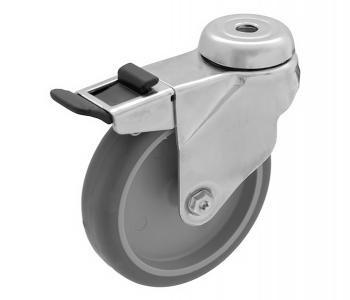White Paper
A
Comparison of Tin-Silver-Copper Lead-Free Alloys
Tin-Silver-Copper alloys are the leading candidate lead-free substitute.
However, as there are several different Tin-Silver-Copper alloys, background
information is necessary to determine which alloy is best suited for the
broadest range of applications. The Sn96.5/Ag3.0/Cu0.5, Sn95.5/Ag3.8/Cu0.7, and
Sn95.5/Ag4.0/Cu0.5 alloys are compared for availability, cost, solder paste
printing, melting, wetting, wave soldering, thermal fatigue and solder joint
reliability.
A
Practical Guide to Achieving Lead-Free Electronics Assembly
To successfully achieve lead-free electronics assembly, each participant in the
manufacturing process, from purchasing to engineering to maintenance to quality
and inspection, must have a solid understanding of the changes required of them.
This pertains to considerations regarding design, components, PWBs, solder
alloys, fluxes, printing, reflow, wave soldering, rework, cleaning, equipment
wear & tear and inspection.
Lead-Contamination
in Lead-Free Electronics Assembly
The question of what happens to a lead-free solder joint if it becomes
contaminated with lead is important because during the transition to lead-free
soldering it is very likely that tin/lead parts will still be used in a great
deal of production. In other words, just because one implements a lead-free
solder alloy does not mean that tin/lead coated components and boards will
disappear immediately. In fact, exposure to lead from boards, components and
repair operations could occur for years to come. This paper discusses the
dynamics of lead contamination and provides real-world examples of failures
caused by the lead contamination of lead-free solders.
Materials
and Process Considerations for Lead-Free Electronics Assembly
With the WEEE Directive in Europe potentially outlawing lead from some
electronic devices produced and imported in the EU by 2006 and foreign
competition driving the implementation of lead-free electronics assembly around
the world, additional questions regarding the integrity and reliability of
various alloy compositions continue to arise. In short, the issue of which
alloy(s) to select continues to loom. This paper shall take an in-depth view of
Sn/Ag, Sn/Ag/Cu and Sn/Cu alloys and compare the reliability testing results and
process considerations for these.
Considerations
for Printing Lead-Free Solder Pastes
SMT printing will require reexamination and process adjustment when lead-free
soldering is implemented. If a high quality solder paste is used and standard
rules for SMT printing are followed, consistent stencil life, aperture release,
print definition, high-speed print capabilities and print repeatability may be
expected. However, implementation of lead-free solder paste does necessitate
some adjustment, as well as providing an opportunity to review and fine-tune
several key printing parameters.
A
Study of Lead-Free Wave Soldering
This brief study of lead-free wave soldering focuses upon copper dissolution and
solder maintenance issues. Unfortunately, it is determined that waste and
changeover costs can dramatically increase with lead-free wave soldering.
A
Study of Antimony
The issue of the toxicity of antimony has arisen as the search for viable
lead-free alloys continues. Confusion regarding the toxicity of antimony has
developed as a result of legislation concerning antimony trioxide, as well as
unfounded speculation concerning the element in an alloyed form. This paper
details third party and governmental studies and legislation concerning antimony
and its "toxicity". This data then is compared to that of the
"safe" elements that comprise the majority of lead-free solders,
including silver, copper, zinc, compounds of tin, as well as lead. This data
indicates that antimony is no more "toxic", often is far
less-stringently regulated, and is classified as less of a health threat than
many of the other aforementioned elements.
A
Study of Lead-Free Alloys
With the ongoing concerns regarding environmental pollutants, lead at one time
was heavily targeted in the electronics assembly arena. AIM reacted to these
concerns by developing its patented lead-free alloy CASTIN®. This paper
highlights the development process and application information for CASTIN®.
Understanding
Lead-Free Alloys
One result of the push to find lead-free solder alternatives is that there are
now many options available to the board assembler. Much development, patterning
and research has gone into finding viable solutions for those who want to
eliminate lead from their process. However, each of these alloys is different in
significant ways and background information is
necessary.
A
Comparison of Lead-Free Alloys
Based on recent market developments, it appears that the choice of suitable
lead-free alloys to replace Tin-Lead for electronics assembly is narrowing.
Three candidates have emerged as potential standards for the industry. They are
the Tin-Copper eutectic (Sn99.3/Cu0.7), the Tin-Silver eutectic (Sn96.5/Ag3.5),
and CASTIN® (Sn96.2/Ag2.5/Cu0.8/Sb0.5). This paper details extensive testing
covering several variables that was conducted in order to make objective
comparisons between the three alloys.






